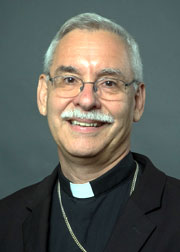Official Website of the
Catholic Diocese of Little Rock
Feast of St. Teresa of Avila 2023
Published: October 15, 2023
Bishop Anthony B. Taylor preached the following homily at the Carmel of St. Teresa of Jesus in Little Rock on Sunday, Oct. 15, 2023.

Bishop Taylor
Since today we celebrate the feast of St. Teresa of Avila, I thought it might be good to remember her story. St. Teresa was born in Avila in 1515 to very pious parents and was raised in the faith. We are told that when she was 7 years old, she and her younger brother ran away from home, intending to go to Morocco to be martyred for the faith by the Moors.
She was 12 when her mother died, and her widowed father had a hard time raising her. She began to keep bad company and so, believing that her morals were in danger, her faither sent her to live with some Augustinian nuns, but that didn’t work out. Teresa became sick and had to return home.
But then she decided on her own to join a religious community, despite the fact that her father forbade her to do so. So, she snuck out of the house and ran away a second time, this time to join the Carmelite convent in Avila, where at age 19 she took vows. Unfortunately, the discipline there was somewhat relaxed. While there, Teresa had a nervous sickenss, of which she was cured by the help of St. Joseph.
By the time of her death, (St. Teresa of Avila) had founded 32 monasteries. She has been declared a doctor of the Church, the first woman ever to be so honored. Teresa was an excellent scholar and writer. Her works on mystical theology continue to be classics. Her autobiography is frank and inspiring, and from a literary point of view, is a classic of Spanish literature.
Gratefully, she dedicated herself to spreading his cult and he remains dear to all Carmelites even today. Her convalescence was followed by severe spiritual conflicts and worldly distractions — her convent was completely open, no enclosure.
Then she read the “Confessions” of St. Augustine, which was a moment of conversion for her and inspired her to give herself completely to the service of God — at which point she began to have mystical experiences. She identified four degrees of prayer: recollection, quietude, union and ecstasy, by means of which she obtained extraordinary graces.
She had visions, apparitions of Christ, and an angel pierced her heart with a golden arrow. She would talk about these things, but the other nuns mocked her and thought she was pretty strange. Not even her confessors understood her, declaring her to be a victim of the deception of the devil. But then, in 1559, St. Peter of Alcántara became her spiritual guide, which was of tremendous help to her.
Out of this came a profound sense of a call from God to reform the Carmelite order. After a long struggle she founded the first convent of Discalced Carmelite Nuns of the Primitive Observance in honor of St. Joseph in 1562. Then within 14 years, by 1576 she had established eight other convents and written her ”Constitutions” which became the rule for all her monasteries.
But then she was forbidden to make any new establishments. Jerome Gratian, the apostolic visitor of the Carmelite friars and nuns in Andalucía resented her efforts and kept things in turmoil for the next four years, during which time Teresa was hounded by the Spanish Inquisition.
Teresa was of Jewish heritage, and so was suspect. Moreover, she was a strong, outspoken woman, and being a woman of integrity, she had offended some who preferred not to be reformed. Her efforts seemed to be lost, until King Phillip II of Spain stepped in on her behalf, and in 1580 Pope Gregory XIII set up Teresa’s foundations as a new province of Carmelites.
By the time of her death, she had founded 32 monasteries. She has been declared a doctor of the Church, the first woman ever to be so honored. Teresa was an excellent scholar and writer. Her works on mystical theology continue to be classics. Her autobiography is frank and inspiring, and from a literary point of view, is a classic of Spanish literature.
The Catholic Church has many reasons to be indebted to Teresa. One is that she and others, for instance St. John of the Cross, succeeded in reforming the Catholic Church of Spain from within.
For this reason, the Protestant reformers did not find Spain to be fertile ground for their efforts. The abuses so prevalent in the Church in other countries had been largely eliminated in Spain by this reform from within. And again, thanks to Teresa and others, the already reformed, fully united Spanish Church became the single most important bulwark of the faith, and the strongest proponent of Catholicism in the Reformation era.









